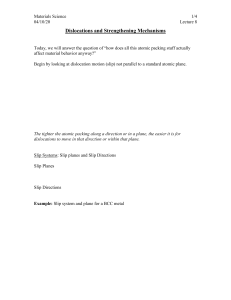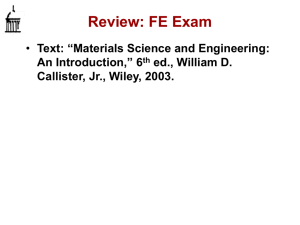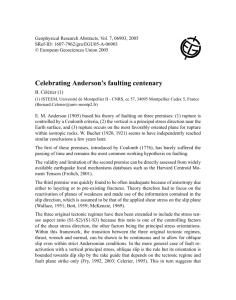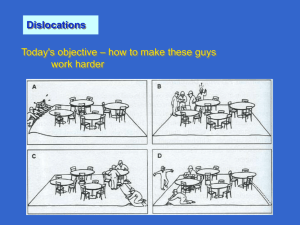Lecture # 11 Dr.Haydar Al-Ethari - Burgers vector - Slip
advertisement
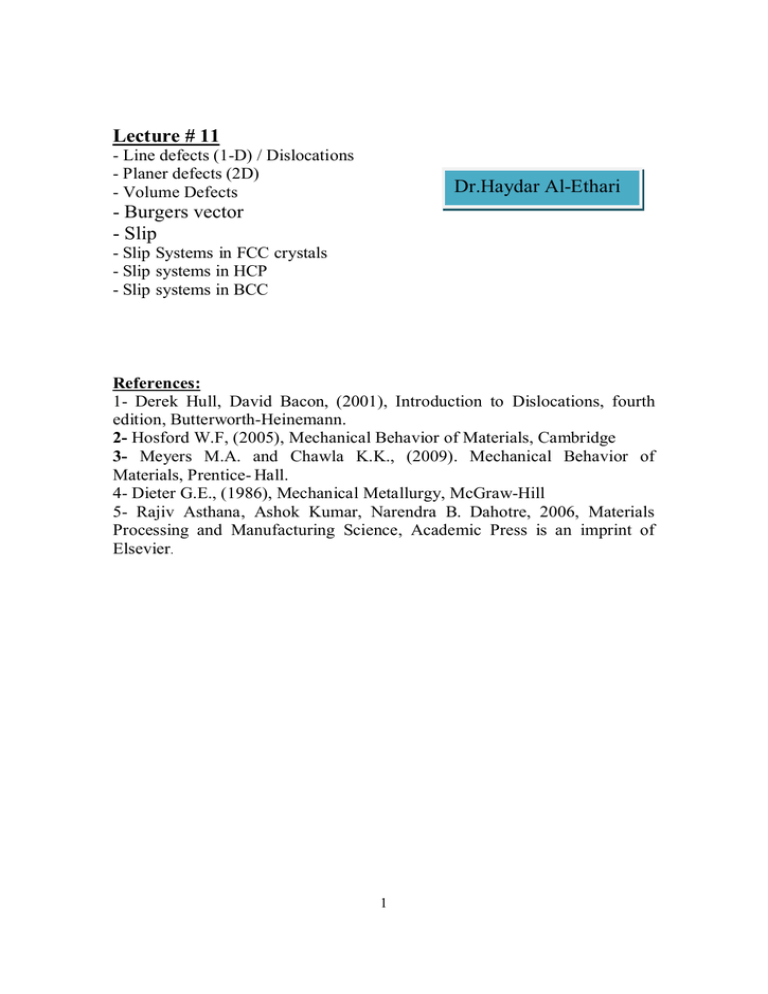
Lecture # 11
- Line defects (1-D) / Dislocations
- Planer defects (2D)
- Volume Defects
Dr.Haydar Al-Ethari
- Burgers vector
- Slip
- Slip Systems in FCC crystals
- Slip systems in HCP
- Slip systems in BCC
References:
1- Derek Hull, David Bacon, (2001), Introduction to Dislocations, fourth
edition, Butterworth-Heinemann.
2- Hosford W.F, (2005), Mechanical Behavior of Materials, Cambridge
3- Meyers M.A. and Chawla K.K., (2009). Mechanical Behavior of
Materials, Prentice- Hall.
4- Dieter G.E., (1986), Mechanical Metallurgy, McGraw-Hill
5- Rajiv Asthana, Ashok Kumar, Narendra B. Dahotre, 2006, Materials
Processing and Manufacturing Science, Academic Press is an imprint of
Elsevier.
1
Line defects (1D) / Dislocations
The approximate calculations show that th is many orders of magnitude
greater than the observed values of the shear stress. This striking difference
between prediction and experiment was accounted for by the presence of
dislocations independently by Orowan, Polanyi and Taylor in 1934.
The dislocation is the defect responsible for the phenomenon of slip, by
which most metals deform plastically, it is the region of localized lattice
disturbance separating the slipped and un slipped regions of a crystal.
Dislocations are also connected with nearly all other mechanical phenomena
such as strain hardening, yield point, creep, fatigue, and brittle fracture.
1st - Edge Dislocation:
(a) Model of a simple cubic lattice; the atoms are represented by filled
circles, and the bonds between atoms by springs.
(b) positive edge dislocation DC formed by inserting an extra half-plane
of atoms in ABCD.
(c) Atomic arrangement in a plane normal to an edge dislocation.
- The atomic arrangement results in compressive stress above the slip plane
2
and a tensile stress below the slip plane.
- An edge dislocation with the extra plane of atoms above the slip plane, is
called a positive edge dislocation and indicated by and if the extra
plane of atoms lies below the slip plane, the dislocation is a negative edge
dislocation, Τ .
(d) Dislocation moves along slip plane in slip direction perpendicular to
dislocation line CD. A pure edge dislocation can glide or slip in a direction
perpendicular to its length. It may move vertically by a process known as
climb, if diffusion of atoms or vacancies can take place.
To move upward (positive direction of climb), it is necessary to remove the
extra atom directly over or to add a vacancy to this spot. If the dislocation
moves down, atoms would have to be added. Movement by climb is
diffusion-controlled, motion is much slower than in glide and less likely
except at high temperatures.
2nd – Screw or Burgers dislocation:
(a) left-handed screw dislocation DC formed by displacing the faces ABCD
relative to each other in direction AB; The dislocation line is parallel to its,
slip vector or (Burgers vector)
(b) spiral of atoms adjacent to the line DC in (a).
3
- A screw dislocation does not have a preferred slip plane, as an edge
dislocation has, and therefore its motion is less restricted than the motion of
an edge dislocation. Movement by climb is not possible with a screw
dislocation.
Burgers vector
The Burgers vector (the amount by which the parts of the crystal have been
displaced with respect to each other) is a characteristic entity of a
dislocation.
(a) The construction of the Burgers vector in an edge dislocation by taking a
loop around the dislocation and the same loop in a dislocation free crystal.
The vector b needed to close the loop is the Burgers vector. Burger vector b
is always perpendicular to the dislocation line.
4
(b) The construction of the Burgers vector in a screw dislocation by taking a
loop around the dislocation and the same loop in a dislocation free crystal.
Notice that the Burgers vector b needed to close the loop in a dislocationfree crystal in such that: the dislocation line is parallel to its Burgers vector.
Planer defects (2D)
All of them distort the periodicity of the crystal lattice and induce strain
fields.
Stacking Faults
Perfect crystals can be described as a stack of atom layers arranged in a
regular sequence. A stacking fault is a planar defect. It is a local region in
the crystal where the regular sequence has been interrupted.
In a face-centered cubic lattice two types of stacking fault are possible:
a) part of a C layer removed this results in a break in the stacking sequence
and an intrinsic fault.
5
b) If an extra A layer has been introduced between a B and a C layer this
referred to as an extrinsic fault.
The presence of stacking faults can play an important role in the plasticity of
crystals. They destroy the perfection of the host crystal. The associated
energy per unit area of fault is known as the stacking-fault energy.
Grain Boundaries:
Grain boundary is an array of dislocations that line up to form a plane
that forms boundary between two crystalline regions (grains) that are
misoriented relative to one another.
Crystalline solids usually consist of a large number of randomly oriented
grains separated by grain boundaries. Each grain is a single crystal and
contains the defects already described. When the misorientation between the
grains is large, the atomic arrangement at the boundary is complicated and
varies significantly with the angle of misorientation.
Grain-boundary dislocations are not mobile dislocations producing
extensive slip; rather, their chief role is that they group together within the
boundary to form a step or grain-boundary ledge. As the misorientation
angle of the grain boundary increases the density of the ledges increases.
Twin Boundaries:
The regular internal structure of a crystal may be interrupted in such a
way that two pieces of the crystal are related to one another by rotation
about an axis or reflection in a mirror plane.
Twins may be produced by mechanical deformation or as the result of
annealing following plastic deformation. The first is called mechanical twins
(or deformation twinning); the letter are called annealing twins.
6
Deformation twinning is a process in which a region of a crystal
undergoes a homogeneous shear that produces the original crystal structure
in a new orientation. In the simplest cases, this results in the atoms of the
original crystal ('parent') and those of the product crystal ('twin') being
mirror images of each other by reflection in a composition plane.
Deformation twinning can be induced by plastic deformation and is
particularly important in body centered cubic and close-packed hexagonal
metals under conditions of rapid rate of loading (shock loading) and
decreased temperature. FCC metals are not ordinarily deform by mechanical
twinning, although gold-silver alloys twin fairly when deformed at low
temperature.
Annealing twins often form in FCC metals such as Cu,Al, Ni that have been
cold worked and annealed. As the crystal regrows a stacking fault leads to
the formation of twins.
The important role of twinning in plastic deformation comes
Volume Defects:
- Inclusions (as MnS in steel), Dispersed particles (as Al2O3 in Al)
- Precipitates (coherent, incoherent, partially coherent)
- Crystal defects such as precipitates, voids and bubbles can occur under
certain circumstances and have important effects on the properties of
crystalline solids. As an example, the interaction of dislocations with
precipitates has played a vital role in the development of high-strength
alloys.
Slip
Plastic deformation of crystalline materials usually occurs by slip, which is
the sliding of planes of atoms over one another. The planes on which slip
occurs are called slip planes and the directions of the shear are the slip
7
directions. These are crystallographic planes and directions that are
characteristic of the crystal structure.
Almost without exception the slip directions are the crystallographic
directions with the shortest distance between like atoms or ions and the slip
planes are usually densely packed planes. Since the planes of greatest atomic
density are the most widely spaced planes in the crystal structure, the
resistance to slip is generally less for these planes than any other set of
planes. The slip plane together with the slip direction establishes the slip
system.
Slip Systems in FCC crystals
The family of close-packed planes in FCC is {111}. There are four such
planes in a crystal, they are: (111) ( 1 11) (1 1 1) (11 1 )
The directions for the vectors shown are r1 = [011], r2 = [1 1 0], r3 = [ 1 01]
and r4 = [01 1 ].
There are 4 close-packed planes with 3 close-packed directions in each plane
< 1 10 > – a total of 12 slip systems.
The close-packed directions are the slip directions. They are: < 1 10 >.
8
There are three such directions for each slip plane, e.g. for the plane (111)
the slip directions are: [ 1 10], [0 1 1] and [10 1 ].
Thus there are 4 slip planes with each having 3 slip directions: A total of 12
slip systems for FCC crystals.
Slip systems in HCP
The close-packed plane in HCP is the basal plane (0001) and there are
3 close-packed directions < 11 2 0 >.
9
Hence in HCP there are 3 slip systems. This low number of slip systems
means that it is difficult to plastically deform an HCP metal. It can be shown
that 5 slip systems must operate in each grain of a polycrystal if it is to
deform in a manner compatible with the deformations of its neighbors. To
meet these constraints the HCP polycrystal must deform by mechanical
twinning to avoid cracking at the grain boundaries.
Since the basal plane is not ideally close-packed, we find that for HCP
crystals slip often takes place on other planes in some materials.
Slip systems in BCC
There are no close-packed planes in BCC. However, there are three types of
planes which are nearly tied for the highest packing density. They are:
near close packed planes in BCC : {110} {321} {211}
All these planes have been observed to be slip planes. Thus we have the
following slip systems in BCC crystals:
6 {110} planes each with 2 < 111 > directions
• 24 {321} planes each with 1 < 111 > direction
• 12 {211} planes each with 1 < 111 > direction
10
i.e. a total of 48 slip systems for BCC crystals.
Since BCC crystals have many possible slip planes intersecting along the
< 111 > direction, they can cross slip.
There are 48 possible slip systems, but since the planes are not so closedpacked as in the FCC structure, higher shearing stresses are usually required
to cause slip.
11
